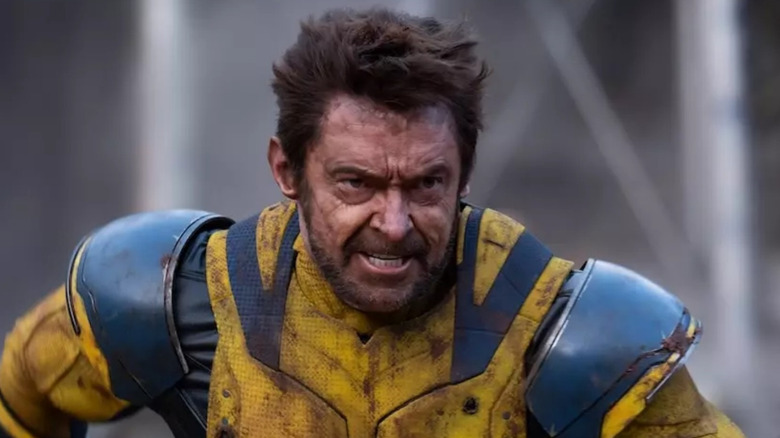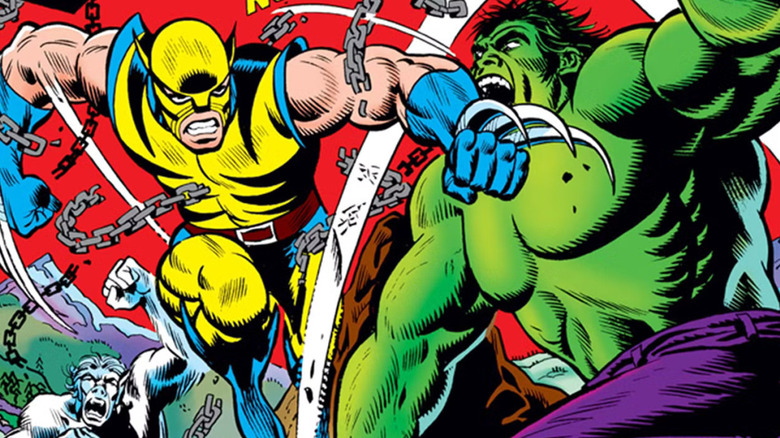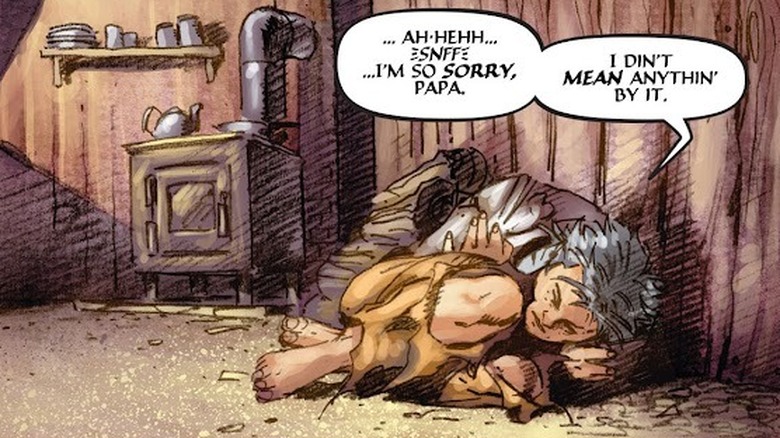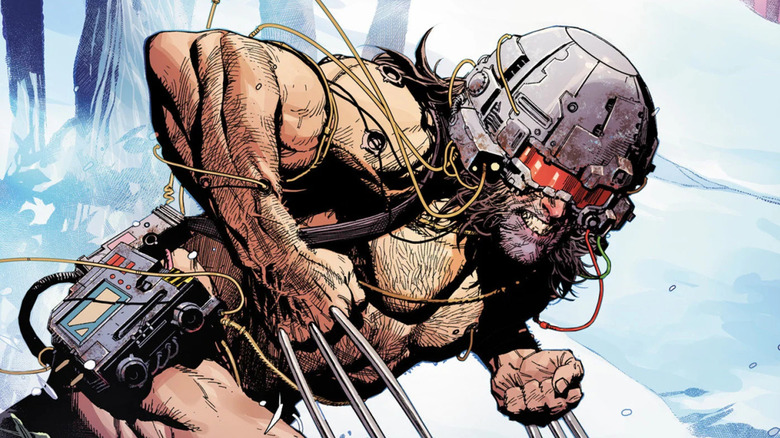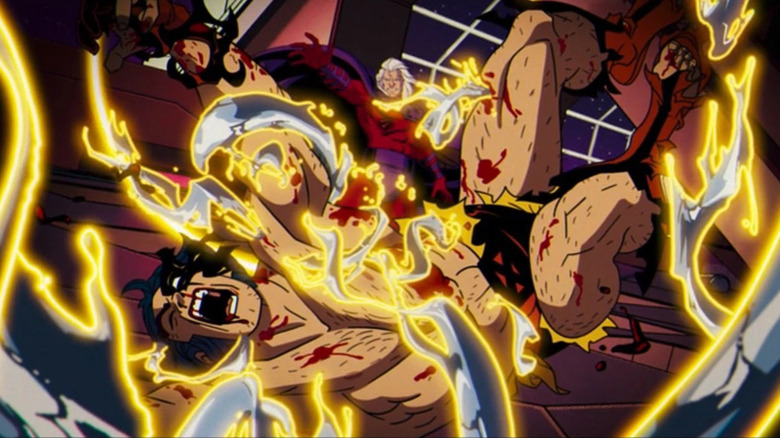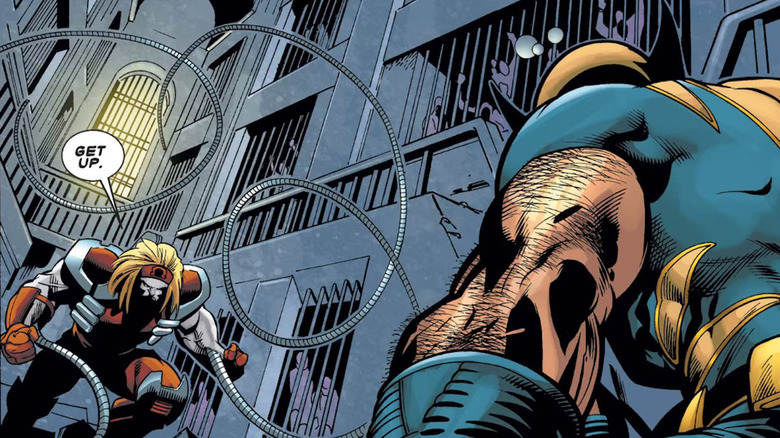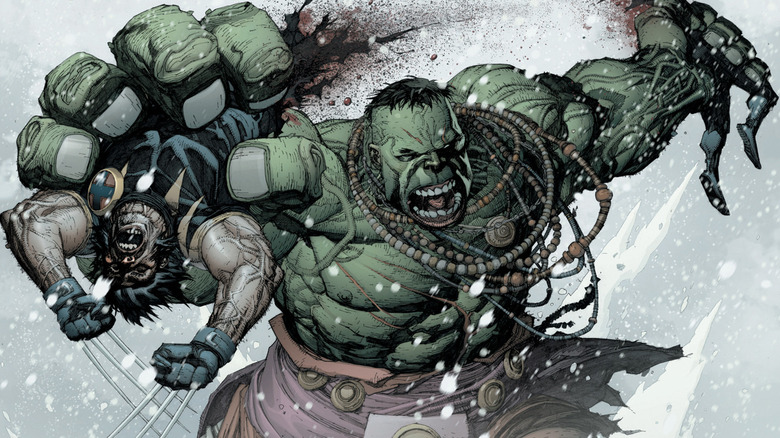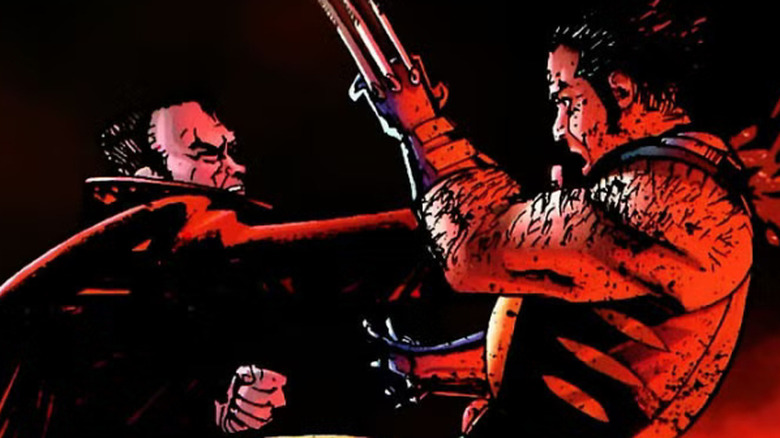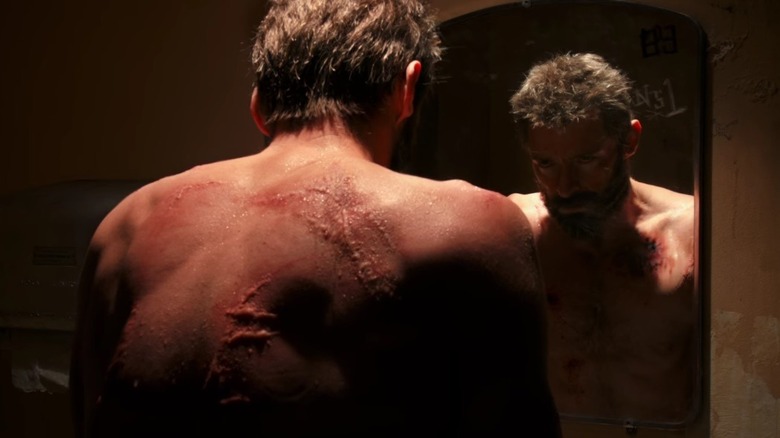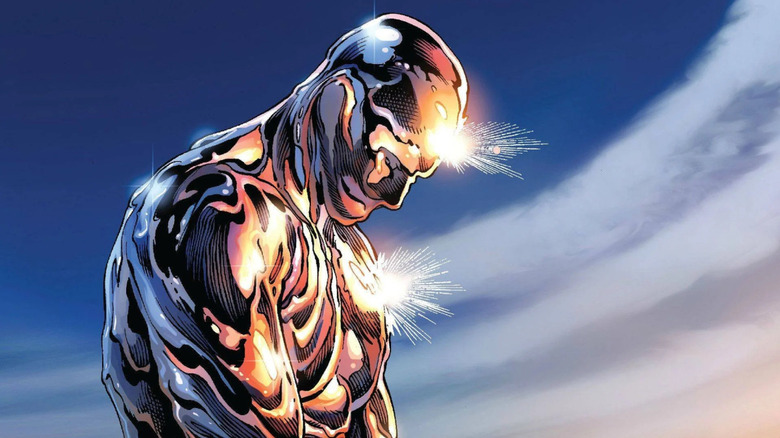Is Wolverine Really Immortal?
It's no secret that Marvel tends to show favoritism to its most popular characters. That's why Spider-Man has multiple comic books coming out every month, for instance. Even heroes that seem to have humble origins can rise to great power in the Marvel universe. Born as James Howlett and adopting the nickname "Logan" as a young man, Wolverine is among the biggest Marvel characters on the screen and the comics, as proven in 2024 by his massively successful on-screen return in "Deadpool and Wolverine."
As a flagship mutant, Wolverine is an extremely strong character not just for his retractable adamantium claws. The limits of Logan's immortality have been tested many times, with some estimating the character to be capable of living to nearly 500 years old as a result of his latent mutant genetics and healing factor. However, that hasn't stopped Logan from meeting some unfortunate fates across his comic book history.
This begs the question: is Wolverine truly immortal, or is that just a common misconception about one of Marvel's most powerful superheroes?
Wolverine's debut established him as a government experiment
It may surprise casual Marvel fans to know that Wolverine's introduction was not as part of the X-Men, who were originally created in 1963's "The Uncanny X-Men" before being canceled in 1970 and later revived in 1975. The clawed Canadian's first comic book appearance was actually as an antagonist in issue #180 of "The Incredible Hulk" in 1974, in which Bruce Banner's uncontrollable rage monster crosses the Canadian border and is subsequently pitted against the Canadian government's "Weapon X" experiment — a clawed assassin in yellow and blue known as the Wolverine.
In this comic, very little was established about Wolverine's backstory or supposed mutant abilities as we now know them. Co-creator Roy Thomas told Forbes that the impetus for the character was very simple, saying, "I had four requirements for the character: that he be named 'Wolverine,' be Canadian, be fierce because wolverines are fierce creatures, and that he be short, because superheroes are usually tall." Originally, the character's metal claws weren't even physically growing from his knuckles, as they were meant to just be coming from his gloves.
Even the character's introduction as a mutated Canadian experiment designed to be fast and vicious was simply meant to contrast the slow-moving and powerful Hulk, with no mention of any kind of healing factor or increased life-span. Wolverine's long-standing comic book rivalry with the Hulk was also recently referenced by a Logan variant from "Deadpool and Wolverine."
His origin story depicts him as a frail child
Despite becoming one of Marvel's most popular characters after joining the X-Men, Wolverine's origin story didn't come until 2001's comic book miniseries "Wolverine: The Origin," written by Paul Jenkins, Bill Jemas, and Joe Quesada. Contrary to his future, James Howlett isn't a powerful X-Man from birth. Born in (approximately) 1882, the character is actually quite a frail child, battling not only allergies but also abuse from his neglectful mother and demanding grandfather.
It doesn't take until the Weapon X program for Wolverine to get his powers: as with many mutants, he discovers his latent abilities in pubescence. In issue #2 of "Wolverine: The Origin," James' biological father, Thomas Logan, shows up late one night to the Howlett estate, drunkenly demanding to not just take James but also his former lover Elizabeth (James' mother). Thomas kills James' grandfather in front of him, causing James' mutation to manifest as bone claws grow from his knuckles, allowing him to kill his father before being driven away by his own mother.
This origin story is adapted in 2009's "X-Men Origins: Wolverine," which depicts James harnessing his mutant powers out of rage and fighting off a fever in the process. In the film, James runs away with Victor Creed, his half-brother (aka Sabretooth), who also possesses a mutation in the form of long, sharp nails and a healing factor like James. In the comics, these further powers come later.
Bone Claw Wolverine was powerful even at a young age
Wolverine's bone claws were Logan's earliest-known mutation, but the coming years showed that he was already quite powerful at this age. As documented throughout the "Wolverine: The Origin" series, these iconic mutations don't come all at once. Logan begins to discover his healing factor as he lives among the elements, and is first given the moniker "Wolverine" after a cage match with a local cook.
But even at a young age, Logan's healing factor proves that killing him won't be easy. In the final issue of "Wolverine: The Origin," Logan and his childhood friend Rose are chased down by Dog Logan, his half-brother, who intends to kill Logan for the murder of their father. As Logan reveals his bone claws for the first time in public, Rose leaps between the two to save Dog and is inadvertently killed by Logan. In the follow-up series "Origin II" from 2014, it's revealed that Logan failed to commit suicide over Rose's death due to his healing factor.
In fact, Wolverine's healing factor is stronger prior to the infusion of adamantium into his skeleton. While Logan has a long way to grow as a hero during his time with just bone claws, it has its advantages for him as a young fighter.
The Weapon X program enhanced Logan even more
Prior to joining the Weapon X program, Logan lives a lot of lives. He serves in two world wars, falls in love with Mystique, and even survives the bombing of Hiroshima. By the 1960s, Logan is 80 years old, yet barely reaches his prime as a superhero when he's captured by government operatives for a highly-experimental procedure of creating Super Soldiers to combat the threat of mutants. This procedure doubles Logan's healing factor, making him a serious menace throughout the decade, until 1974, when he's re-captured for an all-new series of experiments.
Placed in a sensory deprivation tank, Logan is brainwashed as Weapon X scientists infuse his skeleton with the highly-valuable adamantium, turning him into an unstoppable killing machine with a traumatizing costume inspired by the Predator helmet. His entire skeleton, including his bone claws, are coated in pure adamantium, giving Logan increased strength and speed, though it isn't all beneficial to Logan's health.
Although the adamantium turns Logan from a feral monster into a more humanistic character, it clashes severely with his healing factor as the adamantium slowly poisons him over time. Plus, in the case of one frequent X-Men adversary, having his entire skeleton be made of an extremely rare metal is more of a disadvantage than not.
Adamantium put him at a disadvantage against Magneto
1993's "X-Men" issue #25 is notorious for featuring one of the most horrific moments in Marvel Comics. Erik Lensherr, aka Magneto, is a former ally of Charles Xavier who, opposed to the X-Men's pursuit of peace, seeks to punish humankind for its treatment of mutants throughout history. His return in this particular comic posed a challenge for the writers, as Peter David told Comic Book Resources: "The other writers were bouncing around the notion of a huge Magneto/Wolverine slugfest and I said, thinking out loud, 'Boy, y'know, if I'm Magneto, I don't even bother with Wolverine. I just yank out his skeleton and be done with him.'"
To David's surprise, this idea ended up making it into the comics: Magneto rips the adamantium out of Logan's skeleton, nearly killing the most iconic member of the X-Men if not for his healing factor. Surprisingly, the fact that he has bone claws is something Logan has suppressed after all this time, realizing that his mutant powers weren't just the result of the Weapon X experiments. It even led to a several-year-long arc where Wolverine's adamantium claws are no more, until they're returned by Apocalypse.
The iconic comic book moment was even recently adapted in Disney+'s "X-Men '97." What happens to Wolverine when Magneto rips out his adamantium, though, is not easily answered by the season finale.
Wolverine's healing factor can't heal alcoholism
Wolverine's healing factor can keep him from succumbing to some pretty gnarly fates, but the one thing it can't fight is his reliance on alcohol. Canonically, the healing factor is supposed to protect an individual from all earthly diseases and illnesses, including drunkenness, but for a heavy drinker like Logan, he's still able to get plastered on a fairly regular basis. It's even been confirmed in the comics that, while Logan can get extremely intoxicated, the healing factor will simply just sober him up faster.
There is one type of beverage that has been known to get Wolverine drunk — an ambrosia brewed on Krakoa, the island sanctuary for mutants. However, some comic book fans have speculated that Krakoa's ability to provide Logan with an elixir that can get him properly drunk may also be capable of providing him with a poison that could bypass his healing factor, but this has yet to be proven in the comics.
Beyond alcohol, there are ways of killing Wolverine that even his healing factor can't prevent, such as drowning or the Muramasa Blade, a katana forged from part of Logan's soul during his time seeking peace in Japan. Wolverine himself admits that, because of its magical properties, the Muramasa Blade is the only weapon on Earth that can fatally injure him, as proven when he wields it against a clone of Sabretooth and severs his arm, not allowing the healing factor to kick in.
Carbonadium is Logan's kryptonite
There was a time when adamantium was the strongest metal in the Marvel universe, but the comics have introduced minerals that are far more dangerous to a mutant like Wolverine. Carbonadium is one example. A radioactive metal created by the Soviet Union, it first appeared in issue #4 of "X-Men" from 1991, which also featured the debut of one of the fiercest X-Men villains: Omega Red.
Unlike other mutants, Omega Red's primary mutation is a "death factor," which allows him to spray pheromones that can kill any individual in his proximity, as well as drain others of their life force. However, like Wolverine, Omega Red was also experimented on by the Russian government, which installed artificial carbonadium tentacles into his body. While the carbonadium slowly poisons Omega Red, he becomes reliant on draining the life force from others to sustain himself.
In Omega Red's confrontations with Wolverine, the presence of carbonadium is known to weaken Wolverine's healing factor. The only way to stop this radiation is through the use of a Carbonadium Synthesizer, which was once used by Dracula to recruit Omega Red into kidnapping Wolverine so the vampire could steal the X-Man's blood. The 2012 comic series "Deadpool Kills The Marvel Universe" also featured a rampaging Wade Wilson who wields a carbonadium katana, which he uses to finish off Wolverine once and for all.
He has survived some pretty ridiculous injuries
Some comic book fans have wondered just how far Wolverine's healing factor can go to save Logan from catastrophic injuries, and thankfully, some comic book writers have answered those questions. Out of all the Wolverine moments you'll never see on the big screen, one of the more iconic comes from Damon Lindelof's miniseries "Ultimate Wolverine vs. Hulk." Wolverine is assigned to assassinate the Hulk, only for the story to open on a pretty bad note for the mutant as the Hulk tears him in half at the waist.
What's even more ridiculous is that this isn't even the only time Wolverine has survived this excruciating injury, as seen when a clone of himself (Wendigo-Wolverine) tears him in two. In the case of the Wolverine's fight with the Hulk, the two halves of Logan's body are separated from each other, and his top half must climb a mountain to reunite with his bottom half. Another comic book storyline saw the Hulk literally eat Wolverine, only for Logan to claw his way out.
Among the other ridiculous things that Wolverine has survived throughout the comics are his heart being torn out of his chest, being barbecued alive by the sun, and having all of his flesh burned off by Nitro. There is eventually a point in Wolverine's comic book history where the character is literally unkillable, though in the rare case he does somehow die, he always finds a way to come back.
Logan always gets a chance to fight his way out of hell
As previously mentioned, Wolverine has survived some pretty gnarly injuries, but that's not to say he hasn't earned his right to survive. In 1915, during the character's time fighting in World War I, Logan suffers a near-death experience and subsequently encounters Lazaer, who is actually Azrael, the angel of death. However, Logan fights off this angel and is granted the opportunity to live another day, though Azrael promises he'll be back to claim Logan's life if he ever loses one of their matches.
This tradeoff is later explored in the "Wolverine" comic series from issues #57 to #61, thanks to the help of Doctor Strange. Essentially, what would otherwise be a fatal injury for a non-mutant would ostensibly send Logan's soul to purgatory, where he would then have to battle Lazaer to prevent himself from being sent to the afterlife. After his Atlantean girlfriend is killed, Logan loses his will to live, and as a result loses his fight with Lazaer, putting him in a coma.
Wolverine is revived by a mystic named Phaedra, who in return keeps a piece of his soul. Predictably, Wolverine kills her to take it back, but in doing so, makes a deal with Azrael that the next time he faces near-death, he won't get the opportunity to fight his way out of it.
He may seem immortal, but he does age slowly
By now, it seems almost certain that Wolverine isn't just a powerful mutant, but an immortal being capable of cheating death. After all, "Deadpool and Wolverine" establishes the Marvel character to be his timeline's "Anchor Being." But unlike many cosmic beings in the Marvel universe, it wouldn't be fair to call Wolverine one, considering he does in fact age, albeit at a much slower rate than other humans or mutants.
This idea was explored in a comic book series called "Old Man Logan," which takes place in a future where Wolverine has abandoned his superhero life in pursuit of peace and quiet. In this universe, all the familiar Marvel heroes are mysteriously murdered, and it's later revealed that one of the biggest culprits is Logan himself, having been brainwashed by Mysterio's illusions. However, even this elderly Logan still has all his powers, save for a slightly weaker healing factor.
Wolverine's decelerated aging was also showcased in James Mangold's 2017 film "Logan," in which his old age is seen to be significantly decreasing the effectiveness of his healing factor. As established by the comics, the adamantium in Logan's body is slowly poisoning him, and over time, his healing factor isn't keeping him alive as much as it used to. At the end of the film, Logan is finally killed by his own clone after being impaled on a tree branch.
Death of Wolverine finally killed Logan ... for a while
In 2014, Marvel Comics debuted a four-issue miniseries by Charles Soule titled "Death of Wolverine," seemingly setting up the end of the longtime X-Man's journey. At the beginning of the series, Logan has lost his healing factor, giving him very limited time to live due to Wolverine's biggest weakness: the adamantium poisoning his body. In typical Wolverine fashion, Logan decides to spend his last few months hunting down the Weapon X scientists who created his adamantium skeleton.
Logan eventually discovers Dr. Cornelius' experiments on humans to recreate Weapon X, only to discover that without Logan's healing factor, his work cannot be complete. As Cornelius decided to pump liquid adamantium into his experiments, Logan destroys the container, resulting in adamantium smothering him, and kills Cornelius as one of his final actions. In one of the most haunting images in Marvel Comics history, the miniseries ends with an adamantium-coated Logan kneeling, petrified, as the sun sets.
It was a fitting end for the seemingly "unkillable" hero, but even when the comic was released, there was the expectation that "Death of Wolverine" wasn't really the end of Wolverine.
The question remains: is Wolverine truly immortal?
So, to answer it once and for all: is Wolverine immortal? Canonically, no. Although he's extremely hard to kill for good, given not just his healing factor but also his routine fights with the Angel of Death, Wolverine is not fully unkillable. He's also not ageless, showing severe signs of weakening as the years go by, even with his decelerated aging.
This is even true for some iconic immortals in Marvel Comics, like Loki or Thor. But at the end of the day, Wolverine's ability to cheat death has nothing to do with canonical rules, mutant physiology, or even Logan's own will to live, but it does have everything to do with one key factor: the writer.
As Stan Lee himself once explained (via ComicBookMovie.com), "I'm always asked: Who would win in a fight? ... It's so simple, anyone should know this. The person who'd win in a fight is the person that the scriptwriter wants to win!" Wolverine will always be as immortal or as vulnerable as any given writer wants him to be in a comic book, movie, or television show.
If you or anyone you know may be the victim of child abuse, is struggling or in crisis, or needs help with addiction issues, contact the relevant resources below:
- Contact the Childhelp National Child Abuse Hotline at 1-800-4-A-Child (1-800-422-4453) or contact their live chat services.
- Call or text 988 or chat 988lifeline.org.
- Visit the Substance Abuse and Mental Health Services Administration website or contact SAMHSA's National Helpline at 1-800-662-HELP (4357).
